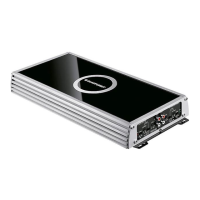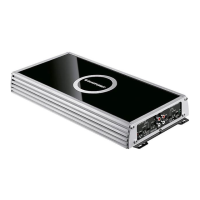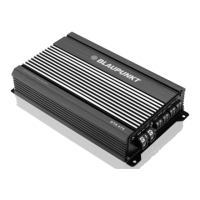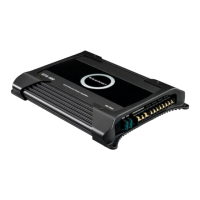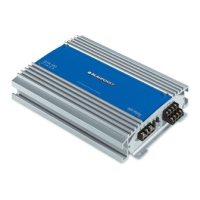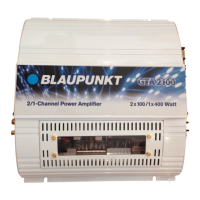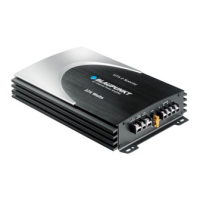GTA 470 DSP
7
Audio inputs
The preampli er outputs are connected to the cinch (RCA)
sockets via a shielded audio line (see Fig. 3).
Plus / minus connection
– We recommend a minimum cross section of 6 mm
2
.
– Route commercially available plus cables to the battery
and connect via fuse holder.
– Use cable glands for holes with sharp edges.
– Securely fasten commercially available minus cables to a
noise-free earth point (chassis screw, chassis metal) (not
to the minus pole of the battery).
– Scrap the contact surfaces of the earth point until they
are bright and grease with graphite grease.
Integrated fuses (2 x 20 A)
The fuses integrated in the ampli er protect the power
ampli er and the entire electrical system in case of an error.
If a replacement fuse is used, never bridge fuses or replace
them with a type with higher current.
Connection examples
Connection of the voltage supply ..................................Fig. 2
Audio inputs ...........................................................................Fig. 3
Loudspeaker connections .................................................Fig. 4 - 8
Remote control connection (optional equipment) ......Fig. 9
+12V
Remote connection of the ampli er with switchable +12 V
voltage source.
This allows the ampli er to be switched on and o using the
on/o -switch of the car sound system.
Loudspeaker connections
(If the ampli er is to be jumpered, continue with the section
"Bridged loudspeaker connections" at this point).
As with every audio component, the correct polarisation of
ampli er and loudspeakers is of essentially importance for a
good bass response. For this reason, ensure that the positive
connection (+) of the ampli er is connected with the posi-
tive connection (+) of the loudspeaker; the same applies to
the negative connections (-). In addition, the left ampli er
channel must be connected with the left loudspeaker and
the right ampli er channel with the right loudspeaker.
Bridged loudspeaker connections
The GTA ampli er can also be bridged for a mono con gura-
tion. This allows the ampli er to be used for one or several
subwoofers or a mid-range driver. In this con guration, the
ampli er combines the right and left channel to a single-
channel output (mono output).
Note:
The ampli er can add the right and left signal information
only if the right as well as the left cinch (RCA) connection
were carried out.
Caution:
In a bridge circuit, the ampli er load must be 4 Ω or
higher. A lower load leads to an overheating or switch-
o of the ampli er and can cause permanent damages.
Subwoofer connection
The GTA 470 DSP features three di erent options of con-
necting a subwoofer:
–An active subwoofer or an additional ampli er are con-
nected with a cinch (RCA) cable to the two SUBWOOFER
OUTPUT sockets (see Fig.7). The setting options of the
integrated DSP (Digital Sound Processor) can be used
in this case.
–A passive subwoofer is connected to the bridged loud-
speaker output (see the section "Bridged loudspeaker
connections"). To be able to use the setting options of
the integrated DSP (Digital Sound Processor), the two
REAR INPUT sockets must additionally be connected with
a commercially available cinch (RCA) cable with the two
SUBWOOFER OUTPUT sockets (see Fig. 8).
–A passive subwoofer is connected to the bridged loud-
speaker output (see the section "Bridged loudspeaker
connections"). The setting options of the integrated DSP
(Digital Sound Processor) cannot be used in this case.
DSP sound settings
(FRONT and REAR loudspeakers)
A variety of options is available to optimise the sound of the
connected loudspeakers:
– GAIN control (FRONT and REAR)
The GAIN control is used to adjust the input sensitivity
of the power ampli er to the output voltage of your car
sound system preamplifier output. The GTA 470 DSP
features separate controls for the FRONT and REAR loud-
speakers. In each case, the adjustment range is from 0.2 V
to 5 V. If a car sound system of a third party manufacturer
is connected, the input sensitivity must be adjusted cor-
responding to the manufacturer data.
A few important explanations in this context:
By turning the GAIN control clockwise, the input sensitivity
of the ampli er and, therefore, also the volume increases.
However, this is not a volume control. In the end position,
it is not possible to achieve a higher ampli er output, even
if it sounds like that at rst. The system merely increases
the volume faster if the volume control of the car sound
system is turned up.
– FULL/HI/LOW switch and X-OVER control
(FRONT and REAR)
For the GTA 470 DSP, the type of frequency crossover
("Low-Pass" or "High-Pass") and the desired cut-o fre-
quency can be adjusted separately for the FRONT and
REAR loudspeakers. Select the cut-o frequency up to
which lower frequencies (high-pass) or higher frequencies
(low-pass) should be blocked. Only frequencies above
the cut-o frequency (high-pass) or below the cut-o
frequency (low-pass) are passed on to the loudspeakers.
The cut-o frequency is dependent upon the frequency
range of the loudspeakers (see recommended frequency
range of the loudspeakers).
"High-Pass" (switch setting: HI)
With a setting of 80 Hz, the ampli er has a frequency range
from 80 Hz to 30,000 Hz.
"Low-Pass" (switch setting: LOW)
This control is active if the switch is in the LOW position,
and allows for setting the desired entry frequency.
GTA_470_DSP_13LG.indd 7GTA_470_DSP_13LG.indd 7 24.08.12 15:4924.08.12 15:49
